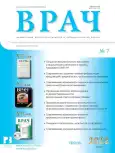Possibilities for the co-use of high-frequency skin ultrasound and contrast-enhanced renal ultrasound in the diagnosis of chronic kidney disease
- Authors: Borsukov A.V.1, Gorbatenko O.A.1, Venidiktova D.Y.1, Tagil A.O.1, Borsukov S.A.1, Kurchenkova V.S.2
-
Affiliations:
- Smolensk State Medical University Ministry of Health of Russia
- Clinical Hospital One
- Issue: Vol 33, No 7 (2022)
- Pages: 29-32
- Section: For Diagnosis
- URL: https://journals.eco-vector.com/0236-3054/article/view/114648
- DOI: https://doi.org/10.29296/25877305-2022-07-05
- ID: 114648
Cite item
Abstract
In Russia, decreased kidney function was diagnosed in 16% of able-bodied people and in 36% of people over 60 years of age. It is necessary to develop additional algorithms for diagnosing this disease for its early detection at the stage of screening, monitoring the development of pathology, and preventing complications. Objective. To evaluate the effectiveness of co-use of high-frequency skin ultrasound and contrast-enhanced renal ultrasound in the diagnosis of chronic kidney disease (CKD). Subjects and methods. The investigation enrolled 34 patients with a documented CKD diagnosis. The patients were divided into groups according to the glomerular filtration rate (GFR): Group 1 consisted of 17 patients with normal or slightly reduced GFR (>60 ml/min/1.73m2); Group 2 included 17 patients with significantly reduced GFR (30-44 ml/min/1.73 m2). The patients were examined according to the unified diagnostic algorithm: B-mode multiparametric renal ultrasound, contrast-enhanced renal ultrasound with the co-application of high-frequency skin ultrasound. Results. The proposed method for determining the severity of CKD, by assessing peripheral microcirculatory abnormalities using contrast-enhanced renal ultrasound and high-frequency skin ultrasound before and during intravenous contrast enhancement, by determining the difference between the values of ratio of acoustic scan lines, showed a high sensitivity (89.5%) and specificity (90.6%). Conclusion. The co-use of high-frequency skin ultrasound and contrast-enhanced renal ultrasound is effective in detecting and monitoring CKD.
Full Text
About the authors
A. V. Borsukov
Smolensk State Medical University Ministry of Health of Russia
Author for correspondence.
Email: 92darv@gmail.com
Professor, MD
O. A. Gorbatenko
Smolensk State Medical University Ministry of Health of Russia
Email: 92darv@gmail.com
D. Yu. Venidiktova
Smolensk State Medical University Ministry of Health of Russia
Email: 92darv@gmail.com
0000-0001-5497-1476
A. O. Tagil
Smolensk State Medical University Ministry of Health of Russia
Email: 92darv@gmail.com
S. A. Borsukov
Smolensk State Medical University Ministry of Health of Russia
Email: 92darv@gmail.com
V. S. Kurchenkova
Clinical Hospital One
Email: 92darv@gmail.com
Smolensk
References
- International Diabetes Federation, 2019. URL: https://www.idf.org/
- Клинические рекомендации Хроническая болезнь почек. Ассоциация нефрологов, 2021; с. 233.
- Sheiman J.A. Патофизиология почки. Пер. с англ. М.: «Издательство БИНОМ», 2019; 192 с.
- Claudon M., Dietrich C.F., Choi B.I., et al. Guidelines and good clinical practice recommendations for contrast enhanced ultrasound (CEUS) in the liver - update 2012: a WFUMB-EFSUMB initiative in cooperation with representatives of AFSUMB, AIUM, ASUM, FLAUS and ICUS. Ultraschall Med. 2013; 34 (1): 11-29. doi: 10.1055/S-0032-1325499
- Барилко М., Селиверстов П., Радченко В. Дисбиоз толстой кишки и хроническая болезнь почек. Врач. 2019; 30 (2): 14-9. doi: 10.29296/25877305-2019-02-02
- Ультразвуковое исследование с применением контрастных препаратов. От простого к сложному. Под общ. ред. А.Н. Сенча. М.: МЕДпресс-информ, 2021; 296 с.
- Molvneux A.S. Neural control of arteriovenous anastomoses. Microvasc Res. 1980; 19 (2): 256-9.
- Родионов А.Н., Заславский Д.В., Сыдиков А.А. Клиническая дерматология. М.: ГЭОТАР-Медиа, 2019.
- Sidhu P.S., Cantisani V., Dietrich C.F. et al. The EFSUMB guidelines and recommendations for the clinical practice of contrast-enhanced ultrasound (CEUS) in non-hepatic applications: update 2017 (long version). Ultraschall Med. 2018; 39 (2): e2-e44. DOI: 10.1055 /a-0586-1107
- Westwood M., Joore M., Grutters J. et al. Contrast-enhanced ultrasound using SonoVue® (sulfur hexafluoride microbubbles) compared with contrast-enhanced computed tomography and contrast-enhanced magnetic resonance imaging for the characterization of focal liver lesions and detection of liver metastases: a systematic review and cost-effectiveness analysis. Health Technol Assess. 2013; 17 (16): 1-243. doi: 10.3310/hta17160
- Weskott H.-P. Контрастная сонография. 1-е изд. Бремен: UNI-MED, 2014; 284 с.
Supplementary files








